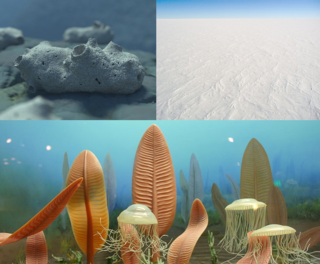
The Ediacaran period is a geological period of the Neoproterozoic era that spans 96 million years from the end of the Cryogenian period at 635 Mya, to the beginning of the Cambrian period at 538.8 Mya. It is the last period of the Proterozoic eon as well as the last of the so-called "Precambrian supereon", before the beginning of the subsequent Cambrian period marks the start of the Phanerozoic eon where recognizable fossil evidence of life becomes common.

The Neoproterozoic Era is the unit of geologic time from 1 billion to 538.8 million years ago.
The Precambrian is the earliest part of Earth's history, set before the current Phanerozoic Eon. The Precambrian is so named because it preceded the Cambrian, the first period of the Phanerozoic Eon, which is named after Cambria, the Latinised name for Wales, where rocks from this age were first studied. The Precambrian accounts for 88% of the Earth's geologic time.

Acritarchs are organic microfossils, known from approximately 1800 million years ago to the present. The classification is a catch all term used to refer to any organic microfossils that cannot be assigned to other groups. Their diversity reflects major ecological events such as the appearance of predation and the Cambrian explosion.

The Mesoproterozoic Era is a geologic era that occurred from 1,600 to 1,000 million years ago. The Mesoproterozoic was the first era of Earth's history for which a fairly definitive geological record survives. Continents existed during the preceding era, but little is known about them. The continental masses of the Mesoproterozoic were more or less the same ones that exist today, although their arrangement on the Earth's surface was different.

The Cryogenian is a geologic period that lasted from 720 to 635 million years ago. It forms the second geologic period of the Neoproterozoic Era, preceded by the Tonian Period and followed by the Ediacaran.

Vaalbara is a hypothetical Archean supercontinent consisting of the Kaapvaal Craton and the Pilbara Craton. E. S. Cheney derived the name from the last four letters of each craton's name. The two cratons consist of crust dating from 2.7 to 3.6 Gya, which would make Vaalbara one of Earth's earliest supercontinents.

The Pilbara Craton is an old and stable part of the continental lithosphere located in the Pilbara region of Western Australia.
Elso Sterrenberg Barghoorn was an American paleobotanist, called by his student Andrew Knoll, the present Fisher Professor of Natural History at Harvard, "the father of Pre-Cambrian palaeontology."

Andrew Herbert Knoll is the Fisher Research Professor of Natural History and a Research Professor of Earth and Planetary Sciences at Harvard University. Born in West Reading, Pennsylvania, in 1951, Andrew Knoll graduated from Lehigh University with a Bachelor of Arts in 1973 and received his Ph.D. from Harvard University in 1977 for a dissertation titled "Studies in Archean and Early Proterozoic Paleontology." Knoll taught at Oberlin College for five years before returning to Harvard as a professor in 1982. At Harvard, he serves in the departments of Organismic and Evolutionary Biology and Earth and Planetary Sciences.

The Ediacaranbiota is a taxonomic period classification that consists of all life forms that were present on Earth during the Ediacaran Period. These were enigmatic tubular and frond-shaped, mostly sessile, organisms. Trace fossils of these organisms have been found worldwide, and represent the earliest known complex multicellular organisms. The term "Ediacara biota" has received criticism from some scientists due to its alleged inconsistency, arbitrary exclusion of certain fossils, and inability to be precisely defined.
The Khatyspyt Formation is a Neoproterozoic formation exposed in the Olenëk Uplift of north central Siberia, which contains the only known instance of the Ediacara biota preserved in a limestone bed. The Khatyspyt Formation forms one of the major parts of the Khorbusuonka Group; underlying the Khatyspyt are dolomites of the Mastakh Formation and their overlying red beds; the Turkut Formation overlies the Khatyspyt. The Khatyspyt and part of the overlying Turkut comprise a major shallowing upward marine carbonate sequence. Khatyspytia is named after this formation.
The Cambrian explosion, Cambrian radiation,Cambrian diversification, or the Biological Big Bang refers to an interval of time approximately 538.8 million years ago in the Cambrian Period of early Paleozoic when there was a sudden radiation of complex life and practically all major animal phyla started appearing in the fossil record. It lasted for about 13 – 25 million years and resulted in the divergence of most modern metazoan phyla. The event was accompanied by major diversification in other groups of organisms as well.

The Seychelles Microcontinent is a microcontinent underlying Seychelles in the western Indian Ocean made of Late Precambrian rock.
The Boring Billion, otherwise known as the Mid Proterozoic and Earth's Middle Ages, is the time period between 1.8 and 0.8 billion years ago (Ga) spanning the middle Proterozoic eon, characterized by more or less tectonic stability, climatic stasis, and slow biological evolution. It is bordered by two different oxygenation and glacial events, but the Boring Billion itself had very low oxygen levels and no evidence of glaciation.
James William Schopf is an American paleobiologist and professor of earth sciences at the University of California Los Angeles. He is also Director of the Center for the Study of Evolution and the Origin of Life, and a member of the Department of Earth and Space Sciences, the Institute of Geophysics and Planetary Physics, and the Molecular Biology Institute at UCLA. He is most well known for his study of Precambrian prokaryotic life in Australia's Apex chert. Schopf has published extensively in the peer reviewed literature about the origins of life on Earth. He is the first to discover Precambrian microfossils in stromatolitic sediments of Australia (1965), South Africa (1966), Russia (1977), India (1978), and China (1984). He served as NASA's principal investigator of lunar samples during 1969–1974.

The Nama Group is a 125,000 square kilometres (48,000 sq mi) megaregional Vendian to Cambrian group of stratigraphic sequences deposited in the Nama foreland basin in central and southern Namibia. The Nama Basin is a peripheral foreland basin, and the Nama Group was deposited in two early basins, the Zaris and Witputs, to the north, while the South African Vanrhynsdorp Group was deposited in the southern third. The Nama Group is made of fluvial and shallow-water marine sediments, both siliciclastic and carbonate. La Tinta Group in Argentina is considered equivalent to Nama Group.
Granomarginata is a genus of spherical Cambrian acritarchs interpreted as a phytoplankton.
The Shuram excursion, or Shuram-Wonoka excursion, is a change in δ13C, or in the ratio of carbon-13 to carbon-12, taking place between around 573 and 562 million years ago, during the Ediacaran Period. It was first noticed in the Wonoka Formation in South Australia in 1990 and later in the Shuram Formation in Oman in 1993. It is the largest negative δ13C excursion in Earth history, and recovery took 50 million years, although the apparent magnitude of the excursion may be distorted due to meteoric water diagenesis.










